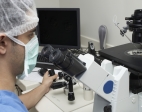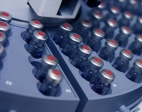Research and Development
The development of Lupuzor™

In the clinic, Lupuzor™ was found to be safe and well tolerated and in addition, in a phase IIa open label trial and then in a double-blind, placebo-controlled dose-ranging, multicentre phase IIb trial, Lupuzor administration significantly improved the clinical biological status of lupus patients who received three subcutaneous doses of 200μg of the drug. A phase III clinical trial is currently in preparation.
Mechanism of action (for specialists)
P140 is a 21-mer linear peptide (sequence 131-151) derived from the spliceosomal small nuclear ribonucleoprotein U1-70K, a major antibody target for lupus autoantibodies. It contains a phosphoserine residue at position 140. In a multicenter, randomized, placebo-controlled phase IIb study, P140/Lupuzor was safe and met its primary efficacy end points in lupus patients (Zimmer et al., ARD 2013). These results confirmed data generated in MRL/lpr lupus-prone mice in which the preclinical studies were conducted (Monneaux et al., Eur. J. Immunol. 2003; Schall et al., J Autoimmunity 2012). In this setting, as in human, P140 was shown to behave as an immunomodulator and not as an immunosuppressant. In a step further, our studies demonstrated that the P140 peptide mechanism of action does involve autophagy processes. In a lupus context in which macroautophagy is affected (Gros et al., Autophagy 2012), P140 readily binds HSPA8/HSC70 chaperone proteins (Page et al., PLoS ONE 2009) and reduces autophagic flux in MRL/lpr B lymphocytes (Page et al., Ann. Rheum. Dis. 2011). We recently showed that a selective form of autophagy is a key target of P140. By interfering with this particular pathway, P140 peptide may affect the endogenous (auto)antigen processing and the peptide loading to class II molecules of the major histocompatibility complex. As a consequence, P140 peptide could induce a reduced activation of deleterious autoreactive T and B cells, and a reduction of pathogenic autoantibodies secreted by plasma cells (Muller and Wallace, Lupus 2014). Experiments are on-going to confirm these data in humans.
Important findings:
P140 provokes the elimination of autoreactive lymphocytes (by apoptosis) but does not affect the capacity of remaining (non-auto-reactive) B and T cells to respond to mitogens (in contrast to other drugs tested).
P140 significantly reduces MRL/lpr CD4+ T cell reactivity towards other peptides (T cell autoepitopes) of the spliceosome, but does not affect normal T cells that react normally to foreign epitopes.
P140 does not affect the resistance of mice to an infectious agent. This means that after P140 treatment, the overall immune system remains intact.
Helpful NotesMeasuring the severity of lupus sufferers: SLEDAI
SLEDAI is the acronym for Systemic Lupus Erythematosus Disease Activity Index, a list of 24 items, 16 of which are clinical items such as seizure, psychosis, organic brain syndrome, visual disturbance, other neurological problems, hair loss, new rash, muscle weakness, arthritis, blood vessel inflammation, mouth sores, chest pain worse with deep breathing and manifestations of pleurisy and/or pericarditis and fever. Eight of the 24 items are laboratory results such as urinalysis testing, blood complement levels, increased anti-DNA antibody levels, low platelets, and low white blood cell count.
Anti-dsDNA autoantibodies
Anti-DNA is an immunoglobulin specific for native (double-stranded, ds) DNA. It is increased in Systemic lupus erythematosus and is highly specific to SLE (called serological maker). 60%-80% of patients with active SLE have a positive anti-DNA test.
Titers of
anti-dsDNA correlate well with disease
activity and a positive test in a person
with lupus symptoms, almost always means
that lupus is present.
clinical trials

Lupuzor has recently started phase III in Europe and the US. The phase III is conducted by Simbec-Orion, a full service international Clinical Research Organisation (“CRO”) specialising in Rare and Orphan conditions with previous direct experience in Lupus trials. Around 15 sites have been chosen in Europe and around 20 in the United States. The dosing of patients is anticipated to begin in Q4 2015.
Completed Clinical TrialsFirst phase II efficacy study: Phase IIa
The Phase IIa study in lupus patients was a proof of concept, dose ranging, safety, multi-centre European study. The drug was administered three times by subcutaneous injections two weeks apart at doses of 200 µg and 1000 µg and the patients were monitored one month after treatment cessation.
Lupus patients who received Lupuzor™ as a lupus treatment on only three occasions, two weeks apart, demonstrated a significant clinical improvement in their condition in addition to the decrease of their biomarkers.
The Phase IIa trial of Lupuzor™ met its primary end-points. The study was designed to measure biomarkers, including reduction in anti-dsDNA autoantibodies and increase in IL10.
Second phase II efficacy study: Phase IIb
A Phase IIb
clinical trial started dosing of
patients in February 2008 in Europe and
Latin America, comparing Lupuzor™ to
placebo plus "standard of care"
(typically steroids) in patients with
systemic lupus erythematosus and an
interim analysis has demonstrated
statistically significant superiority of
Lupuzor™ over placebo plus "standard of
care".
The interim analysis was performed and reviewed by an independent Data Monitoring Committee according to ICH (International Conference on Harmonisation) guidelines. This analysis was conducted after 125 randomised patients had completed the 12-week treatment period, half of them having also completed the additional 12-week follow-up (week 24).
The primary efficacy measure was a ‘SLEDAI response’ defined as a decrease of at least four points in the SLEDAI score, a scale generally accepted by physicians as an assessment of the clinical activity of lupus patients, a lower score representing lower disease activity. The analysis of the data has demonstrated that the 200mcg dose of Lupuzor™ administered every four weeks was statistically significantly superior to placebo (p = 0.015). Lupuzor™ was generally well tolerated with no significant drug related adverse events recorded.

Publications of Lupuzor papers in prestigious medical journals.
A number of scientific papers were published by researchers from the CNRS in peer review scientific journals outlining the work having been carried out by ImmuPharma and the CNRS over the last decade on Lupuzor.
Scientific Publications

A number of further papers are expected to be published soon on Lupuzor in prestigious scientific journals
coming soon
Special article "Resetting the autoreactive immune system with a therapeutic peptide in lupus" on autophagy
download
New Opportunities for Therapy of Autoimmune Diseases: published in Genetics & Epigenetics outlinung the potential in other indications
download
Publication of Lupuzor's double blind phase IIb results in the Annals of the Rheumatic Diseases of the British Medical Journal
download
Publication in the Journal of Autoimmunity on Peptide-based approaches to treat lupus and other autoimmune diseases
download
Annals of the Rheumatic Diseases paper on mode of action of Lupuzor on HSC70+ antigen-presenting cells
download
Publication in PLoS One - Lupuzor (P140) controls Lupus by interacting with the HSC70 protein and via a mechanism mediated by γδ T cells
download
Results of an early phase II clinical trial of Lupuzor published in ARTHRITIS & RHEUMATISM of the American College of Rheumatology
download
Publication in The Journal of Immunology on the selective modulation of CD4 T cells from Lupus Patients by P140 (Lupuzor)
download